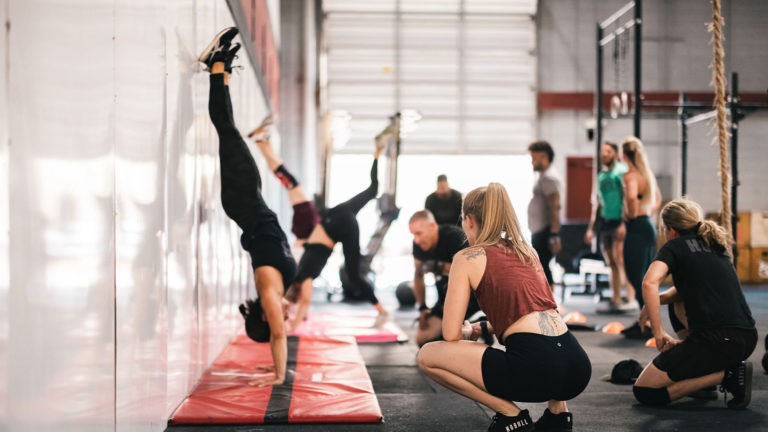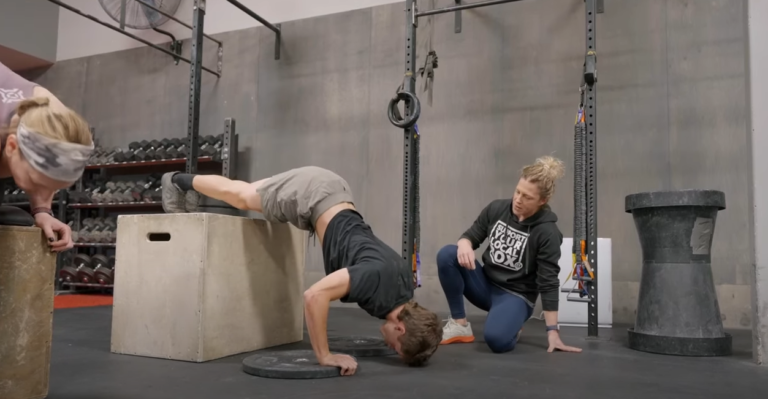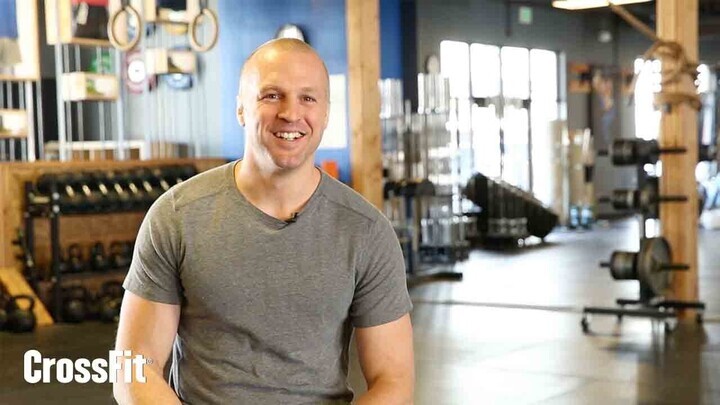Question: How Can I Help Athletes Master Skills When Our Gym’s Standard Scaling Options Aren’t Working?
April 16, 2025
Question: How Can I Help Athletes Master Skills When Our Gym’s Standard Scaling Options Aren’t Working?
Every coach eventually encounters an athlete who fails to reach their potential — whether it’s mastering a skill like muscle-ups or achieving results they’re clearly capable of. While athletes may feel frustrated, it’s the coach who must analyze what’s holding the athlete back. Here are a few reasons athletes plateau and how to help them break through these barriers.
 This is what I call “lazy coaching,” and most of us are guilty of it. It is the trend of scaling the same person the same way all the time, and it’s a disservice to our athletes. For example, every time a muscle-up is programmed, the athlete does a combination of ring rows and banded ring dips, or every time a pull-up is programmed, the athlete does band-assisted pull-ups, etc. For new athletes, having some consistency in their scaling can be beneficial and less confusing for them in what can already be an overwhelming endeavor. However, for those who have been around for a while, this trend will lead to premature plateaus, so it’s essential to vary your scaling options.
This is what I call “lazy coaching,” and most of us are guilty of it. It is the trend of scaling the same person the same way all the time, and it’s a disservice to our athletes. For example, every time a muscle-up is programmed, the athlete does a combination of ring rows and banded ring dips, or every time a pull-up is programmed, the athlete does band-assisted pull-ups, etc. For new athletes, having some consistency in their scaling can be beneficial and less confusing for them in what can already be an overwhelming endeavor. However, for those who have been around for a while, this trend will lead to premature plateaus, so it’s essential to vary your scaling options.
For these athletes, if you have a genuine desire to help them, you will have them perform a movement progression that will advance them toward their potential. Most commonly, this means scaling a workout toward skill development and capacity instead of modifying a high-skill movement to easier elements.
For example, try to preserve elements of a muscle-up instead of reverting to pull-ups and dips all the time. There are many variations of this movement to enhance their development. There are variations of the skill with the feet on the ground in various positions, with feet on a box, utilizing bands, or even combining movements like a kip swing and high-box get-over to replicate the stimulus. Your creativity in implementing new tools to further their development will likely be a welcome addition to their workouts.
A key ingredient that ensures variation of scaling options is ensuring the programmer adds variance not only to the workouts but to the primary scaling options provided. This contributes to Fault 1, listed above. Luckily, there is an easy remedy for this: rotate different scaling options.
I talked with Pamela Gagnon for the CrossFit Training YouTube channel, and we discussed this topic. She suggests rotating scaling options monthly. So, during a pull-up workout, an intermediate athlete might do banded pull-ups as the primary scale in January, toe-spotted pull-ups in February, and a combination of kip swings and ring rows in March. This is a simple plan to implement and nearly guarantees that athletes will be provided options that engage them and progress them toward the full expression of the skill.
If your job is to implement someone else’s programming, and it doesn’t rotate scaling options or always scales challenging movements to an easier variation, ask if they would be willing to talk with you about programming and respectfully express your concerns.
 If you notice your gym as a whole or an individual lacks a specific skill, you likely need to increase the frequency of the skill beyond what is programmed in your daily workout. If handstand skills are programmed as part of your workout only one to two times per month, it will be challenging to develop them.
If you notice your gym as a whole or an individual lacks a specific skill, you likely need to increase the frequency of the skill beyond what is programmed in your daily workout. If handstand skills are programmed as part of your workout only one to two times per month, it will be challenging to develop them.
Fortunately, creating class lesson plans where you effectively utilize your warm-ups and cool-downs can do wonders. For example, it’s easy to implement five to 10 minutes of dedicated handstand drills one to two times per week as part of the post-workout timeframe, especially after a short workout that doesn’t require high skills. This doesn’t seem like much, but if you factor in 2 x 10-minute skill sessions a week for 12 weeks, you have gained four hours of handstand practice time — this is huge!
My recommendation is to test an element you want to work on, create a weekly template that allows you to practice the skill one to two times per week, ensure the skill work progresses from week to week, and then re-test the skill at the end of the 12-week timeframe.
The primary goal of scaling is to preserve the intended stimulus of the workout for each athlete, regardless of their capacity. This is most commonly done in a manner that helps drive athletes toward increased intensity. This is great and should be the primary focus. However, as athletes gain experience, scaling EVERY workout does not need to be the aim. It is a viable option to scale athletes to focus on a skill or a weakness if it will help to further their development. This may slow athletes down at times. That’s OK. Having athletes slow down and perform conditioning workouts with a challenging muscle-up drill instead of scaling them to a faster-paced combination of pull-ups and dips may be necessary for their overall development.
Scaling with a focus on skill is one means to target a weakness, but this can apply to other weaknesses, too. For example, if an individual with a strength deficiency always scales the weight but performs all the prescribed reps, you can coach them to use more challenging loads while reducing the reps. Doing this one time a week for these athletes may lead to an improvement in their overall capacity.
 You should work with your athletes to guide them on how to scale workouts. In the beginning stages of development, athletes should have little say regarding movements, loads, reps, etc. Over time, they will become well-informed and may have ideas about how they should scale workouts. However, these athletes still need to be guided because, if left to choose for themselves, they will likely stay in their comfort zone.
You should work with your athletes to guide them on how to scale workouts. In the beginning stages of development, athletes should have little say regarding movements, loads, reps, etc. Over time, they will become well-informed and may have ideas about how they should scale workouts. However, these athletes still need to be guided because, if left to choose for themselves, they will likely stay in their comfort zone.
One of your jobs as a coach is to consistently provide reasonable challenges for your athletes. You can be direct and tell these experienced athletes what you want them to do (and some will appreciate this), but many respond better to collaboration. Simply asking them if they are willing to try a certain movement or load, and mentioning you are confident in their ability to handle it can create buy-in and trust. You might get some pushback at times, but most of the time, after the workout, the athlete appreciates the challenge and is happy you were thoughtful enough to encourage them.
I’d love to know if there is another fault you’d add to this list.
Want to learn more about scaling? Take our online scaling course here.
Have a question for a coach? Please submit that here.
 Eric O’Connor is a Content Developer and Seminar Staff Flowmaster for CrossFit’s Education Department and the co-creator of the former CrossFit Competitor’s Course. He has led over 400 seminars and has more than a decade of experience coaching at a CrossFit affiliate. He is a Certified CrossFit Coach (CF-L4), a former Division 1 collegiate wrestler, and a former CrossFit Games athlete.
Eric O’Connor is a Content Developer and Seminar Staff Flowmaster for CrossFit’s Education Department and the co-creator of the former CrossFit Competitor’s Course. He has led over 400 seminars and has more than a decade of experience coaching at a CrossFit affiliate. He is a Certified CrossFit Coach (CF-L4), a former Division 1 collegiate wrestler, and a former CrossFit Games athlete.